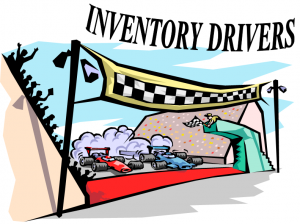 As discussed in my previous posting on Outbound Lead Time there are three different types of Lead Time, all of which affect Inventory Levels in similar but different ways. The three types are Inbound, Internal and Outbound lead-time. In this posting I want to concentrate on Inbound Lead Time. As with Outbound Lead Time, Inbound also has two significant aspects to it – Logistics and Supplier Lead Time. Normally these two aspects are combined together in that the supplier will quote a total lead time from when they receive the Purchase Order to when you can expect delivery at a specific location. Of course, this is assuming that the supplier is arranging shipment of the product. Sometimes however, it is NOT desirable for them to be arranging the shipment in which case you need to get involved in the logistics again. Even when the supplier does arrange the shipments it is still a good idea to at least review their logistical decisions. For example, when picking a delivery company (usually trucking) there will be certain biases that will be applied to determine which company to use. If these are not in line with your own biases then the disconnect will end up generating pressure for more inventory on hand. As an example, let’s say your supplier picks their trucking companies purely by cheapest cost. You then need to ask, why are they the cheapest and, more importantly, what are they skimping on to reduce costs. In this case, let’s say that the upshot of this decision is that the shipping company is not good at hitting delivery times. Depending on how much variance there is between requested delivery time and actual delivery time this could create a shortage for your shipping or manufacturing departments. In order to ensure that this does not happen, your organization comes under increased pressure to keep a higher safety stock level. (Ordering material to arrive before it is needed is just another type of safety stock and in Lean terms, is also a waste.) This extra safety stock has the potential for two types of pain. First and most obvious is the carrying cost of the extra inventory. The second type of pain is tied to the space required. If your material goes into tanks, silos or fixed storage locations there may not be enough physical room for the material to be stored. In these cases there is a fine line between the earliest that material can be received and the latest (stock out) it can be received. In cases like this it actually may be easier and cheaper to pay a little more up front for a better shipping company and pay a little less in inventory and warehousing costs.
As discussed in my previous posting on Outbound Lead Time there are three different types of Lead Time, all of which affect Inventory Levels in similar but different ways. The three types are Inbound, Internal and Outbound lead-time. In this posting I want to concentrate on Inbound Lead Time. As with Outbound Lead Time, Inbound also has two significant aspects to it – Logistics and Supplier Lead Time. Normally these two aspects are combined together in that the supplier will quote a total lead time from when they receive the Purchase Order to when you can expect delivery at a specific location. Of course, this is assuming that the supplier is arranging shipment of the product. Sometimes however, it is NOT desirable for them to be arranging the shipment in which case you need to get involved in the logistics again. Even when the supplier does arrange the shipments it is still a good idea to at least review their logistical decisions. For example, when picking a delivery company (usually trucking) there will be certain biases that will be applied to determine which company to use. If these are not in line with your own biases then the disconnect will end up generating pressure for more inventory on hand. As an example, let’s say your supplier picks their trucking companies purely by cheapest cost. You then need to ask, why are they the cheapest and, more importantly, what are they skimping on to reduce costs. In this case, let’s say that the upshot of this decision is that the shipping company is not good at hitting delivery times. Depending on how much variance there is between requested delivery time and actual delivery time this could create a shortage for your shipping or manufacturing departments. In order to ensure that this does not happen, your organization comes under increased pressure to keep a higher safety stock level. (Ordering material to arrive before it is needed is just another type of safety stock and in Lean terms, is also a waste.) This extra safety stock has the potential for two types of pain. First and most obvious is the carrying cost of the extra inventory. The second type of pain is tied to the space required. If your material goes into tanks, silos or fixed storage locations there may not be enough physical room for the material to be stored. In these cases there is a fine line between the earliest that material can be received and the latest (stock out) it can be received. In cases like this it actually may be easier and cheaper to pay a little more up front for a better shipping company and pay a little less in inventory and warehousing costs.
There are also many reasons why you may want to arrange the shipping yourself. If the supplier arranges the shipment they will usually bury the cost in the overall cost of the material, including upcharges to ensure they do not lose money on transport. More importantly, there may be reasons where you arranging the shipment opens up options not available to the supplier. For instance, if you have a couple of suppliers in the same area with LTL loads you could easily arrange one truck with multiple stops to pick up and deliver all the material. Another possibility is that, depending on the size of your company you may be able to negotiate a cheaper rate than a smaller supplier can. Maybe you can use your delivery trucks to then pick up material from suppliers in the same area. There is a direct connection between how often material is delivered and how much inventory you need to keep. A regular “milk run” set-up can often reduce total inventory levels. It may not even be a money issue. Maybe you just want to deliver material straight to your customers from the supplier and do not want the supplier to arrange it (shipping paperwork would reflect the suppliers name rather than yours). Direct delivery would essentially eliminate that inventory from your books.
The other aspect I mentioned was the Supplier Lead Time, basically this is their version of Internal Lead Time. It is the length of time it takes them to receive an order, process the order and prepare it for shipment. While this is not really under your control, do remember again that there is a direct link between the length of time for something to happen and the amount of inventory you need to carry. It might be worthwhile to pay a little more for material from a supplier with a shorter lead time if it allows you to reduce your inventory costs overall. Supplier lead time is actually a great differentiator when you are deciding between different suppliers. Do not just look at the cost quoted. You need to add in additional internal costs that you will be covering depending on which supplier you pick. If one supplier’s lead time will require you to keep extra stock on hand and the cost to do this is more than the cost difference between the suppliers then you need to ask who is really cheaper. Very few organizations add in the indirect costs for any decision (such as which supplier to buy from), mostly because it can be painful to determine what they are. The problem is that the indirect costs can accumulate to a very expensive total.
Just to give you an something additional to think about, implementing a Lean Six Sigma program will give you a number of tools for identifying and eliminating many of these costs.
Next posting we will explore the effects caused by your internal lead time. In the meantime, enjoy thinking about this topic. Talk to your friends and co-workers about their experience and thoughts on this topic, especially what it means for your organization. And, as always, I would love to hear back on your (and their) thoughts.


You must log in to post a comment.